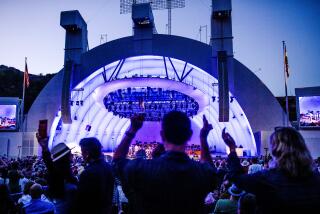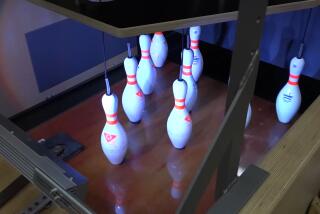Piece of Milwaukee heritage rolls away
- Share via
MILWAUKEE — The brick factories sit silent and empty. The beer barons died long ago. Even Laverne and Shirley are a distant memory.
People here have learned to live with loss. But when city elders heard that the United States Bowling Congress was planning to move to Texas, they weren’t going to just sit by and watch it leave.
Milwaukee bowlers proudly call their home America’s Tenpin Capital. To them, it’s a place where people are as passionate about beer as they are about bowling. It’s as ingrained in the town’s fabric as golf is in Augusta, Ga., and NASCAR in Daytona Beach, Fla.
Since the 1800s, when German and Polish immigrants seeking factory jobs brought the game to this southeastern Wisconsin city, blue-collar men and women have flocked to wooden lanes after the end-of-shift whistles. Kids here still celebrate their birthdays with a few frames, and professional bowlers drop by their old haunts to show off trick shots -- like throwing strikes at will with a towel -- to wide-eyed onlookers.
“It seemed like a bad joke,” said Jim Paetsch, director of corporate expansion and relocation for the Milwaukee 7, the region’s largest economic redevelopment organization.
Paetsch’s group and a team of civic leaders mapped out financial incentives, enough to transform an empty field -- or possibly a defunct ice-rink project -- into expansive new offices. There would be a bowling-themed hotel; a museum filled with leather shoes, wooden pins and tavern songs; and a high-tech testing and training laboratory, where virtual reality programs would chart the trajectory of a bowler’s delivery and gauge the perfect rotation of a ball’s spin.
But the U.S. Bowling Congress had far bigger problems than location, bowling officials said. A recent survey it commissioned showed that more of the public considered archery a sport than bowling. Membership is down. Fewer young people bowl as often as their forebears did, and fewer bowl in organized leagues. Only 38 bowling alleys are left in the greater Milwaukee area -- a steep drop from a late 1970s peak of 83 -- according to Doug Schmidt, author of “They Came to Bowl: How Milwaukee Became America’s Tenpin Capital.”
The congress was tempted to leave when officials in Arlington, Texas, offered it nearly $700,000 from a special state economic development fund -- plus the promise of lower property taxes -- to move its 190-employee headquarters from the Milwaukee suburb of Greendale to a glass-and-brick complex in the Dallas exurb.
The bid this year to keep the congress in Milwaukee brought a sense of hope to southern 13th Street, the working-class address of the Bob-E-Lanes bowling alley.
The tavern and its six lanes were built in 1923, putting them among the country’s oldest certified lanes still in operation. For decades, local keglers (the word is from the German kegeln for bowling, and kegel for pin) have passed through its scarred wooden front door and crowded inside the two-story brick building, eager to grab a beer and gossip in the lanes. It’s still a favorite; the cigarette smoke gets so thick above the marble-look Formica bar that owner Jim Rydzewski has to vacuum the ceiling.
When his parents bought the bowling alley in 1971, “we’d have leagues coming in to play at 9 a.m., and more at noon, and some at midnight,” Rydzewski said. “As long as the factories were running, we were running.”
Shuffling across the darkened alley on a recent Friday afternoon, he fired up the pin-setter and turned on the lights. Electric beer signs flickered to life. Blatz. Pabst. Schlitz.
“We have beer and we have bowling,” said Rydzewski, gazing at the wood-paneled walls and gold-speckled mirrored tiles. “This is a classy place, in true Milwaukee style.”
English, Dutch and German immigrants brought their variations of the game to America when they settled on the East Coast and in the Midwest, where it was often treated as a working-class game of chance, said Schmidt. Bowling became so popular in Wisconsin that preachers put lanes in church basements. Factory owners organized teams to compete in leagues. The local newspapers had weekly pages in the sports section devoted to people who had bowled a perfect game.
“Back in the late 1970s, one out of every six people in the greater Milwaukee area was a sanctioned bowler,” Schmidt said, “including kids.”
By the 1980s, the city’s manufacturing base had begun to erode. As the factories closed, so did the bowling alleys. When Rydzewski took over the bar from his mother in 1981, there were 12 places to bowl within a 2-square-mile area. Now there are two.
But elsewhere, bowling is making a comeback.
A growing number of boutique bowling centers are luring people to an upscale version of the sport. And according to the National Federation of State High School Assns., bowling is the fastest-growing sport on U.S. high school campuses -- beating out ice hockey, water polo and gymnastics in the last school year.
That’s part of Arlington’s appeal. It’s smaller than Milwaukee, but its population is relatively young and growing. It also puts the U.S. Bowling Congress in a sports-centric neighborhood: The offices are to be near the Texas Rangers’ Ballpark at Arlington, a planned $1.1-billion football stadium for the Dallas Cowboys, and a sprawling sports-themed complex expected to break ground this year.
The congress will also be neighbors of the Bowling Proprietors Assn. of America, which represents more than 3,400 bowling centers. The trade group has been pressing the congress to head south and join forces with them, to help convince a new generation of keglers and fans that bowling is as serious and hip a sport as football or baseball. Case in point: Bowling returns to network TV this weekend, for the first time in nearly a decade, with 16 of the congress’ top players battling.
“We’ve seen the future of bowling, and it’s in Texas,” said congress spokesman Mark Miller.
Milwaukee civic leaders console themselves that their area is home to eight Fortune 500 headquarters, and such national organizations as the Movement Disorder Society and the National Funeral Directors Assn.
“Go on. Go ahead. We’ll be just fine,” said suburban Cudahy Mayor Ryan McCue, one of the civic leaders pushing to keep the congress. “It’s not like we’re going to stop bowling here in Wisconsin because the U.S. Bowling Congress is gone.”
--
More to Read
Go beyond the scoreboard
Get the latest on L.A.'s teams in the daily Sports Report newsletter.
You may occasionally receive promotional content from the Los Angeles Times.










